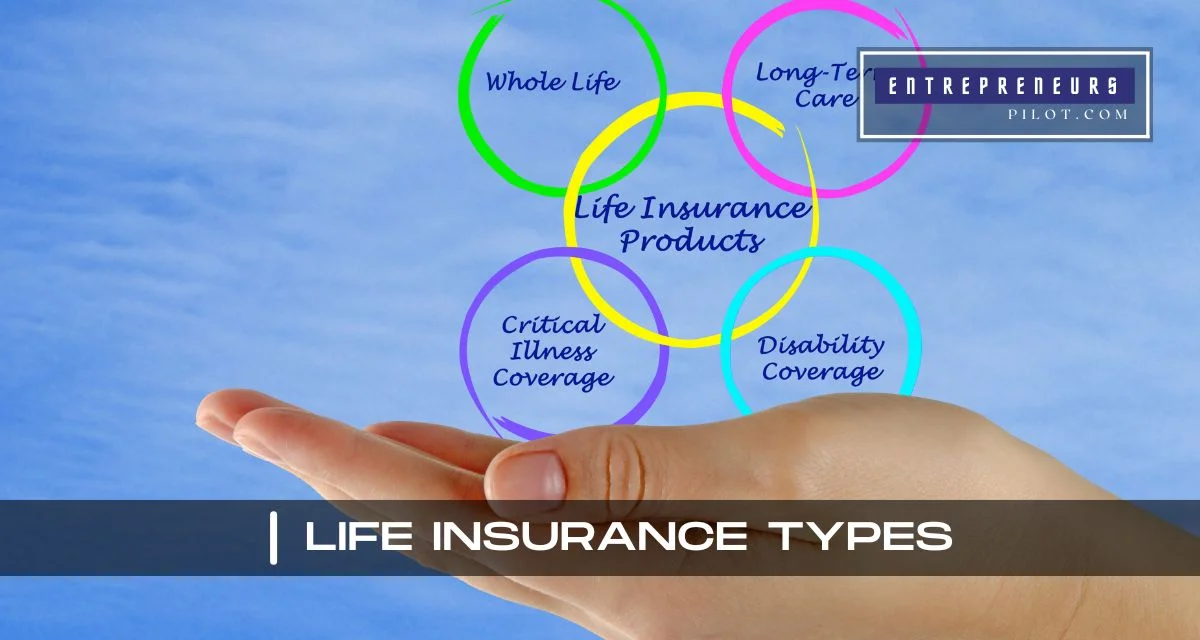Introduction
Life insurance is a crucial part of financial planning for individuals and families. It is a policy that provides a payment to the beneficiaries in the event of the policyholder’s death. Life insurance can help alleviate the financial burden that can arise when a loved one passes away by providing financial security and protection. There are various types of life insurance policies available in the market, each with its own features, benefits, and drawbacks.
Understanding the different types of life insurance policies is essential when selecting the right coverage to meet your specific needs. In this article, we will provide a comprehensive overview of the different life insurance types, so you can make an informed decision about which policy is right for you.
Table of Contents
Life Insurance Vs Whole Life Insurance
Life insurance and whole life insurance are two types of insurance policies that provide financial protection in the event of the policyholder’s death. The key difference between these two policies lies in the coverage period and the investment component.
life insurance, also known as term life insurance, provides coverage for a specified period, typically ranging from one to thirty years. It pays a death benefit to the beneficiaries if the policyholder dies during the coverage period. The premiums for life insurance policies are generally lower than those of whole life insurance policies because they only cover the policyholder for a limited time. Once the coverage period ends, the policy expires, and there is no payout.
- For Expert Financial Insights And Guidance, You Can Visit Our Sister Site – ArabsGeek.com Now!
- Curiosity Piqued? Dive Into the Most Captivating Financial Content by Visiting Our Homepage!
- Unlock Exclusive Business Opportunities! 🚀 Connect with Us Now at our Email: [email protected]!
Whole life insurance, on the other hand, provides coverage for the policyholder’s entire life. It also includes an investment component that builds cash value over time. The premiums for whole life insurance are typically higher than those of term life insurance because they provide lifelong coverage and include the investment component. The investment component allows the policyholder to build up cash value over time, which they can borrow against or use to pay premiums.
When considering life insurance vs. whole life insurance, it’s essential to consider your individual needs and financial goals. If you need coverage for a specific period, such as while you have dependents or a mortgage, term life insurance may be the right choice. If you’re looking for lifelong coverage and want an investment component, whole life insurance may be a better option. Ultimately, it’s important to carefully review the benefits and costs of each type of policy before making a decision.
Life Insurance and AD&D
Life insurance and accidental death and dismemberment (AD&D) insurance are two types of insurance policies that provide financial protection in the event of the policyholder’s death. Although both policies provide a death benefit, there are some key differences between them.
Life insurance pays a death benefit to the beneficiaries if the policyholder dies from any cause, whether it’s an illness, accident, or natural causes. The policyholder pays a premium for the policy, and the beneficiaries receive the payout upon the policyholder’s death.
AD&D insurance, on the other hand, only pays a death benefit if the policyholder dies due to an accident, such as a car crash, drowning, or fall. The policy may also provide additional benefits if the policyholder is injured and becomes disabled as a result of an accident. The premiums for AD&D insurance are typically lower than those for life insurance because it only provides coverage for accidents.
It’s important to note that AD&D insurance is not a substitute for life insurance. Since it only pays out if the policyholder dies in an accident, it may not provide adequate coverage for those who die from natural causes or illness. If you’re considering purchasing AD&D insurance, it’s important to carefully review the policy and its limitations to determine whether it’s the right type of coverage for your needs.
In summary, while both life insurance and AD&D insurance provide a death benefit, life insurance provides coverage for any cause of death, whereas AD&D insurance only provides coverage for accidents. It’s important to consider your individual needs and financial goals when choosing between these two types of policies.
Life Insurance Versus Annuity
Life insurance and annuities are two different types of financial products that can provide financial protection and security. Although both offer a way to provide financial support, there are some key differences between the two.
Life insurance is a policy that pays a death benefit to the beneficiaries if the policyholder dies. The policyholder pays a premium for the policy, and the beneficiaries receive the payout upon the policyholder’s death. Life insurance can be a way to provide for loved ones after the policyholder’s passing and help cover expenses such as funeral costs, mortgage payments, and other outstanding debts.
An annuity, on the other hand, is a contract between the annuitant (the person purchasing the annuity) and an insurance company. The annuitant pays a lump sum or series of payments to the insurance company, which then pays the annuitant a fixed or variable stream of income for a specified period, typically for the rest of their life. An annuity can provide a source of regular income during retirement and can be a way to help ensure financial stability.
While both life insurance and annuities can provide financial security, they serve different purposes. Life insurance is primarily designed to provide for loved ones in the event of the policyholder’s death, while annuities are designed to provide a steady stream of income during retirement. It’s important to carefully consider your individual needs and financial goals when choosing between these two types of products. In summary, life insurance and annuities serve different purposes and provide different types of financial protection.
Life insurance provides a death benefit to beneficiaries upon the policyholder’s passing, while annuities provide a stream of income during retirement. Understanding the differences between these two products can help you make an informed decision about which is right for you.
Life Insurance Or Annuity
Life insurance and annuities are both financial products that provide financial protection and security, but they serve different purposes. It’s important to carefully consider your individual needs and financial goals when choosing between the two.
Life insurance is primarily designed to provide for loved ones in the event of the policyholder’s death. It pays a death benefit to the beneficiaries if the policyholder dies, and the beneficiaries receive the payout upon the policyholder’s death. Life insurance can be a way to provide for loved ones after the policyholder’s passing and help cover expenses such as funeral costs, mortgage payments, and other outstanding debts.
An annuity, on the other hand, is designed to provide a steady stream of income during retirement. It is a contract between the annuitant (the person purchasing the annuity) and an insurance company. The annuitant pays a lump sum or series of payments to the insurance company, which then pays the annuitant a fixed or variable stream of income for a specified period, typically for the rest of their life. An annuity can be a way to help ensure financial stability during retirement.
When choosing between life insurance and annuities, it’s important to consider your individual needs and financial goals. If you’re primarily concerned with providing for loved ones after your passing, life insurance may be the better choice. If you’re more concerned with ensuring financial stability during retirement and want a steady stream of income, an annuity may be a better option.
In summary, life insurance and annuities serve different purposes and provide different types of financial protection. Life insurance provides a death benefit to beneficiaries upon the policyholder’s passing, while annuities provide a stream of income during retirement. Understanding the differences between these two products can help you make an informed decision about which is right for you.
Life Insurance Versus AD&D
Life insurance and accidental death and dismemberment (AD&D) insurance are both types of insurance policies that provide financial protection in the event of the policyholder’s death, but they have some key differences.
Life insurance pays a death benefit to the beneficiaries if the policyholder dies from any cause, whether it’s an illness, accident, or natural causes. The policyholder pays a premium for the policy, and the beneficiaries receive the payout upon the policyholder’s death.
AD&D insurance, on the other hand, only pays a death benefit if the policyholder dies due to an accident, such as a car crash, drowning, or fall. The policy may also provide additional benefits if the policyholder is injured and becomes disabled as a result of an accident. The premiums for AD&D insurance are typically lower than those for life insurance because it only provides coverage for accidents.
While both types of insurance policies provide a death benefit, life insurance is a more comprehensive type of coverage, as it provides coverage for any cause of death, whereas AD&D insurance only provides coverage for accidents. It’s important to consider your individual needs and financial goals when choosing between these two types of policies. In summary, life insurance provides coverage for any cause of death, while AD&D insurance only provides coverage for accidents.
Life insurance is a more comprehensive type of coverage, and it’s important to carefully review the policy and its limitations when considering the type of coverage that best suits your needs. AD&D insurance may be more appropriate for those who engage in high-risk activities, such as extreme sports, and want additional protection in the event of an accident.
Life Insurance Versus Health Insurance
Life insurance and health insurance are two distinct types of insurance policies that provide different types of coverage.
Life insurance provides financial protection to the policyholder’s beneficiaries in the event of the policyholder’s death. It pays out a death benefit to the beneficiaries upon the policyholder’s death, and the payout can be used to cover expenses such as funeral costs, outstanding debts, and living expenses. Life insurance does not provide any coverage for medical expenses or healthcare costs.
Health insurance, on the other hand, is designed to provide coverage for medical expenses and healthcare costs. It pays for doctor’s visits, hospital stays, prescription medications, and other medical treatments. Health insurance can be purchased individually or through an employer-sponsored plan, and the coverage and benefits vary depending on the plan.
While life insurance and health insurance are different types of policies, they can both be important components of a comprehensive financial plan. Life insurance can provide peace of mind for the policyholder’s loved ones in the event of the policyholder’s death, while health insurance can help cover the often-high costs of medical care.
In summary, life insurance provides financial protection to beneficiaries in the event of the policyholder’s death, while health insurance provides coverage for medical expenses and healthcare costs. Both types of insurance can be important components of a comprehensive financial plan, and it’s important to carefully consider your individual needs and financial goals when choosing between the two.
Life Insurance Or Roth IRA
Life insurance and Roth IRAs are two different types of financial products that serve different purposes.
Life insurance provides financial protection to the policyholder’s beneficiaries in the event of the policyholder’s death. It pays out a death benefit to the beneficiaries upon the policyholder’s death, and the payout can be used to cover expenses such as funeral costs, outstanding debts, and living expenses. Life insurance can be a good option for individuals who have dependents, such as children or elderly parents, who rely on their income.
A Roth IRA, on the other hand, is a retirement savings account that allows individuals to save for retirement while also taking advantage of tax benefits. Contributions to a Roth IRA are made with after-tax dollars, which means that withdrawals in retirement are tax-free. A Roth IRA can be a good option for individuals who want to save for retirement and have tax-free income in retirement.
When deciding between life insurance and a Roth IRA, it’s important to consider your individual financial goals and needs. If you have dependents who rely on your income, life insurance may be a better option to provide financial protection in the event of your death. If you are looking to save for retirement and take advantage of tax benefits, a Roth IRA may be a better option.
In summary, life insurance and Roth IRAs serve different purposes and provide different types of financial protection. Life insurance provides financial protection to the policyholder’s beneficiaries in the event of the policyholder’s death, while a Roth IRA is a retirement savings account that allows individuals to save for retirement and take advantage of tax benefits. It’s important to carefully consider your individual financial goals and needs when choosing between these two options.
Life Insurance Or 401K
Life insurance and 401(k) plans are two different types of financial products that serve different purposes.
Life insurance provides financial protection to the policyholder’s beneficiaries in the event of the policyholder’s death. It pays out a death benefit to the beneficiaries upon the policyholder’s death, and the payout can be used to cover expenses such as funeral costs, outstanding debts, and living expenses. Life insurance can be a good option for individuals who have dependents, such as children or elderly parents, who rely on their income.
A 401(k) plan, on the other hand, is a retirement savings plan that allows employees to save for retirement through payroll deductions. Contributions to a 401(k) plan are made with pre-tax dollars, which means that the money is invested tax-free until it is withdrawn in retirement. Employers may also offer matching contributions to the plan, which can help boost retirement savings.
When deciding between life insurance and a 401(k) plan, it’s important to consider your individual financial goals and needs. If you have dependents who rely on your income, life insurance may be a better option to provide financial protection in the event of your death. If you are looking to save for retirement and take advantage of tax benefits, a 401(k) plan may be a better option.
It’s important to note that both life insurance and a 401(k) plan can be important components of a comprehensive financial plan. Life insurance can provide peace of mind for the policyholder’s loved ones in the event of the policyholder’s death, while a 401(k) plan can provide a way to save for retirement and take advantage of tax benefits.
In summary, life insurance and 401(k) plans serve different purposes and provide different types of financial protection. Life insurance provides financial protection to the policyholder’s beneficiaries in the event of the policyholder’s death, while a 401(k) plan is a retirement savings plan that allows individuals to save for retirement and take advantage of tax benefits. It’s important to carefully consider your individual financial goals and needs when choosing between these two options.
Conclusion: Life Insurance Types
In conclusion, life insurance is an important financial tool that can provide valuable protection to individuals and their loved ones. Understanding the different types of life insurance policies available is crucial in selecting the right coverage that meets specific needs and preferences. Term life insurance offers affordable and straightforward coverage for a fixed period, while permanent life insurance provides lifelong protection and additional investment opportunities.
Variable life insurance and universal life insurance are types of permanent life insurance that offer greater flexibility and investment options. Ultimately, the type of life insurance that is best for an individual will depend on their financial goals, risk tolerance, and personal circumstances. It is important to carefully consider all options and consult with a licensed insurance professional to make an informed decision about life insurance coverage.
FAQs: Life Insurance Types
01. What is the difference between term life insurance and permanent life insurance?
Term life insurance provides coverage for a specific period of time, typically ranging from one to 30 years. Permanent life insurance provides coverage for the entirety of a person’s life. Permanent life insurance also includes a cash value component, which allows policyholders to accumulate savings that can be used for a variety of purposes.
02. What is the difference between whole life insurance and universal life insurance?
Whole life insurance is a type of permanent life insurance that provides a fixed premium, death benefit, and cash value component. Universal life insurance, on the other hand, offers more flexibility in terms of premium payments and death benefits, allowing policyholders to adjust coverage as their needs change.
03. How does variable life insurance differ from other types of life insurance?
Variable life insurance is a type of permanent life insurance that allows policyholders to invest their premiums in various investment options, such as stocks, bonds, and mutual funds. This means that the cash value of the policy can fluctuate based on the performance of these investments, making it a riskier option than other types of life insurance.
04. Can I switch from term life insurance to permanent life insurance?
Yes, many insurance providers allow policyholders to convert their term life insurance policy to a permanent life insurance policy without the need for a medical exam. This is a good option for individuals who want lifelong coverage and the ability to accumulate cash value.
05. Is life insurance necessary if I already have health insurance?
Yes, life insurance is a separate type of insurance that provides financial protection for your loved ones in the event of your death. Health insurance only covers medical expenses, so life insurance is important for ensuring that your family is financially protected in the event of an unexpected loss.











